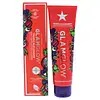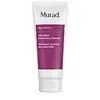What's inside
What's inside
 Key Ingredients
Key Ingredients

 Benefits
Benefits

 Concerns
Concerns

 Ingredients Side-by-side
Ingredients Side-by-side

Water
Skin ConditioningSodium C14-16 Olefin Sulfonate
CleansingMagnesium Aluminum Silicate
AbsorbentKaolin
AbrasiveSodium Cocoamphoacetate
CleansingCetearyl Alcohol
EmollientGlyceryl Stearate
EmollientGlycerin
HumectantMicrocrystalline Cellulose
AbsorbentPropanediol
SolventEuterpe Oleracea Fruit Extract
Punica Granatum Fruit Extract
AntioxidantPunica Granatum Seed Powder
AbrasiveLycium Barbarum Fruit Extract
AstringentCamellia Sinensis Leaf Extract
AntimicrobialCamellia Sinensis Leaf Powder
ExfoliatingMalpighia Glabra Fruit Extract
Skin ConditioningVaccinium Myrtillus Fruit Extract
Skin ConditioningLavandula Angustifolia Flower/Leaf/Stem Extract
MaskingCitrus Limon Fruit Extract
MaskingCitrus Aurantium Dulcis Fruit Extract
MaskingCoffea Arabica Seed Extract
MaskingPyrus Malus Fruit Extract
Skin ConditioningRubus Idaeus Fruit Extract
AstringentElettaria Cardamomum Seed Extract
PerfumingAcer Saccharum Extract
Skin ConditioningPaullinia Cupana Seed Extract
Skin ConditioningCarica Papaya Fruit Extract
Skin ConditioningCucumis Sativus Fruit Extract
EmollientSalvia Officinalis Leaf Extract
CleansingFucus Vesiculosus Extract
EmollientRosmarinus Officinalis Leaf Extract
AntimicrobialCitrus Aurantium Amara Flower Extract
RefreshingCucumis Melo Fruit Extract
Skin ConditioningRosa Centifolia Flower Extract
AstringentJasminum Officinale Flower Extract
MaskingSantalum Album Wood Extract
PerfumingCananga Odorata Flower Extract
PerfumingCupressus Sempervirens Leaf/Nut/Stem Oil
EmollientMorinda Citrifolia Fruit Extract
Skin ConditioningGarcinia Mangostana Fruit Extract
Skin ConditioningPapain
Skin ConditioningHydrolyzed Quinoa
Skin ConditioningHydrolyzed Linseed Seed
HumectantTocopheryl Acetate
AntioxidantBromelain
Skin ConditioningEthylhexylglycerin
Skin ConditioningTriethyl Citrate
MaskingCitric Acid
BufferingXanthan Gum
EmulsifyingCocamidopropyl Hydroxysultaine
CleansingMaltodextrin
AbsorbentSodium Chloride
MaskingAlgin
MaskingDisodium Adenosine Triphosphate
Skin ConditioningDiatomaceous Earth
AbrasiveParfum
MaskingLinalool
PerfumingHexyl Cinnamal
PerfumingHydroxyacetophenone
AntioxidantPhytic Acid
Phenoxyethanol
PreservativePolydiallyl Phthalate
Tea-Sulfate
BufferingWater, Sodium C14-16 Olefin Sulfonate, Magnesium Aluminum Silicate, Kaolin, Sodium Cocoamphoacetate, Cetearyl Alcohol, Glyceryl Stearate, Glycerin, Microcrystalline Cellulose, Propanediol, Euterpe Oleracea Fruit Extract, Punica Granatum Fruit Extract, Punica Granatum Seed Powder, Lycium Barbarum Fruit Extract, Camellia Sinensis Leaf Extract, Camellia Sinensis Leaf Powder, Malpighia Glabra Fruit Extract, Vaccinium Myrtillus Fruit Extract, Lavandula Angustifolia Flower/Leaf/Stem Extract, Citrus Limon Fruit Extract, Citrus Aurantium Dulcis Fruit Extract, Coffea Arabica Seed Extract, Pyrus Malus Fruit Extract, Rubus Idaeus Fruit Extract, Elettaria Cardamomum Seed Extract, Acer Saccharum Extract, Paullinia Cupana Seed Extract, Carica Papaya Fruit Extract, Cucumis Sativus Fruit Extract, Salvia Officinalis Leaf Extract, Fucus Vesiculosus Extract, Rosmarinus Officinalis Leaf Extract, Citrus Aurantium Amara Flower Extract, Cucumis Melo Fruit Extract, Rosa Centifolia Flower Extract, Jasminum Officinale Flower Extract, Santalum Album Wood Extract, Cananga Odorata Flower Extract, Cupressus Sempervirens Leaf/Nut/Stem Oil, Morinda Citrifolia Fruit Extract, Garcinia Mangostana Fruit Extract, Papain, Hydrolyzed Quinoa, Hydrolyzed Linseed Seed, Tocopheryl Acetate, Bromelain, Ethylhexylglycerin, Triethyl Citrate, Citric Acid, Xanthan Gum, Cocamidopropyl Hydroxysultaine, Maltodextrin, Sodium Chloride, Algin, Disodium Adenosine Triphosphate, Diatomaceous Earth, Parfum, Linalool, Hexyl Cinnamal, Hydroxyacetophenone, Phytic Acid, Phenoxyethanol, Polydiallyl Phthalate, Tea-Sulfate
Water
Skin ConditioningSodium C14-16 Olefin Sulfonate
CleansingJojoba Esters
EmollientCocamidopropyl Betaine
CleansingAcrylates Copolymer
Glycol Stearate
EmollientPropanediol
SolventGlycolic Acid
BufferingLactic Acid
BufferingSalicylic Acid
MaskingDipotassium Glycyrrhizate
HumectantSodium Ascorbyl Phosphate
AntioxidantSodium PCA
HumectantUrea
BufferingYeast Amino Acids
HumectantTrehalose
HumectantInositol
HumectantTaurine
BufferingBetaine
HumectantCitric Acid
BufferingSodium Hydroxide
BufferingPolyquaternium-4
Sodium Chloride
MaskingTetrasodium Glutamate Diacetate
Tetrasodium EDTA
Leuconostoc/Radish Root Ferment Filtrate
AntimicrobialTocopherol
AntioxidantEthylhexylglycerin
Skin ConditioningChlorphenesin
AntimicrobialSodium Benzoate
MaskingWater, Sodium C14-16 Olefin Sulfonate, Jojoba Esters, Cocamidopropyl Betaine, Acrylates Copolymer, Glycol Stearate, Propanediol, Glycolic Acid, Lactic Acid, Salicylic Acid, Dipotassium Glycyrrhizate, Sodium Ascorbyl Phosphate, Sodium PCA, Urea, Yeast Amino Acids, Trehalose, Inositol, Taurine, Betaine, Citric Acid, Sodium Hydroxide, Polyquaternium-4, Sodium Chloride, Tetrasodium Glutamate Diacetate, Tetrasodium EDTA, Leuconostoc/Radish Root Ferment Filtrate, Tocopherol, Ethylhexylglycerin, Chlorphenesin, Sodium Benzoate
 Reviews
Reviews

Ingredients Explained
These ingredients are found in both products.
Ingredients higher up in an ingredient list are typically present in a larger amount.
Citric Acid is an alpha hydroxy acid (AHA) naturally found in citrus fruits like oranges, lemons, and limes.
Like other AHAs, citric acid can exfoliate skin by breaking down the bonds that hold dead skin cells together. This helps reveal smoother and brighter skin underneath.
However, this exfoliating effect only happens at high concentrations (20%) which can be hard to find in cosmetic products.
Due to this, citric acid is usually included in small amounts as a pH adjuster. This helps keep products slightly more acidic and compatible with skin's natural pH.
In skincare formulas, citric acid can:
While it can provide some skin benefits, research shows lactic acid and glycolic acid are generally more effective and less irritating exfoliants.
Most citric acid used in skincare today is made by fermenting sugars (usually from molasses). This synthetic version is identical to the natural citrus form but easier to stabilize and use in formulations.
Read more about some other popular AHA's here:
Learn more about Citric AcidEthylhexylglycerin (we can't pronounce this either) is commonly used as a preservative and skin softener. It is derived from glyceryl.
You might see Ethylhexylglycerin often paired with other preservatives such as phenoxyethanol. Ethylhexylglycerin has been found to increase the effectiveness of these other preservatives.
Propanediol is an all-star ingredient. It softens, hydrates, and smooths the skin.
It’s often used to:
Propanediol is not likely to cause sensitivity and considered safe to use. It is derived from corn or petroleum with a clear color and no scent.
Learn more about PropanediolSodium C14-16 Olefin Sulfonate is a cleansing agent made from a mixture of long chain sulfonate salts. It can also help produce foam.
This ingredient may be drying. We recommend speaking with a professional if you have concerns.
Chances are, you eat sodium chloride every day. Sodium Chloride is also known as table salt.
This ingredient has many purposes in skincare: thickener, emulsifier, and exfoliator.
You'll most likely find this ingredient in cleansers where it is used to create a gel-like texture. As an emulsifier, it also prevents ingredients from separating.
There is much debate on whether this ingredient is comedogenic. The short answer - comedogenic ratings don't tell the whole story. Learn more about comegodenic ratings here.
The concensus about this ingredient causing acne seems to be divided. Research is needed to understand if this ingredient does cause acne.
Scrubs may use salt as the primary exfoliating ingredient.
Learn more about Sodium ChlorideWater. It's the most common cosmetic ingredient of all. You'll usually see it at the top of ingredient lists, meaning that it makes up the largest part of the product.
So why is it so popular? Water most often acts as a solvent - this means that it helps dissolve other ingredients into the formulation.
You'll also recognize water as that liquid we all need to stay alive. If you see this, drink a glass of water. Stay hydrated!
Learn more about Water